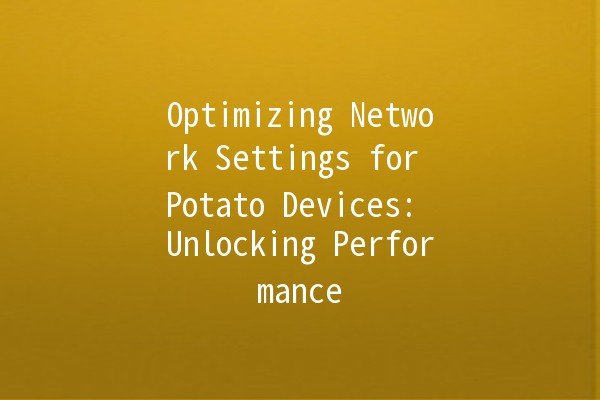In an age dominated by technology, the efficiency of network settings can significantly impact the performance of devices, especially when it comes to specialized technology like the Potato device. Whether you are a developer, a product manager, or an enthusiast, understanding how to configure network settings for your Potato drastically enhances its capabilities. This article delves into practical tips and techniques that can help you optimize the Potato's network performance, ensuring a smoother user experience and greater productivity.
Understanding Potato Devices and Their Networking Needs
Potato devices, typically used in a variety of applications from IoT to home automation, require efficient network configurations to communicate effectively. Their performance is often influenced by factors like bandwidth, latency, and security settings. Knowing how to tweak your network settings can transform the efficiency of these devices.
Five Key Techniques for Optimizing Potato Networking Performance
Technique 1: Set a Static IP Address
One of the easiest ways to enhance your Potato's performance is by assigning a static IP address. Dynamic IP addresses can change with every reboot or disconnection, which may cause interruptions and delays.
Implementation Example:

This ensures that your Potato always connects using the same IP, reducing latency and improving connectivity reliability.
Technique 2: Optimize WiFi Signal Strength
For Potato devices relying on WiFi, signal strength is crucial. Low signal strength can lead to higher latency and disconnections.
Implementation Example:
By increasing the WiFi signal strength, your Potato can maintain a steadier connection to the network.
Technique 3: Enable Quality of Service (QoS)
Quality of Service is a feature that prioritizes bandwidth for specific applications or devices. By enabling QoS for your Potato, you can ensure it receives the necessary bandwidth for optimal performance.
Implementation Example:
This ensures that your Potato performs well, even when multiple devices are using the network simultaneously.
Technique 4: Use IPv6
Switching to the Internet Protocol version 6 (IPv6) can enhance your Potato device's performance and connectivity. IPv6 can route traffic more efficiently, reducing latency and connection issues.
Implementation Example:
By utilizing this modern protocol, your Potato device can enjoy a more stable and responsive connection.
Technique 5: Regularly Update Firmware
Keeping your Potato device firmware up to date is essential for performance optimization. Updates often include important security patches and performance enhancements that can resolve bugs and improve functionality.
Implementation Example:
Regular firmware updates will not only enhance performance but also prolong the lifespan of your Potato device.
Common Questions About Potato Network Optimization
To find the current IP address assigned to your Potato:
Access your router’s dashboard.
Look for connected devices.
Identify your Potato and note down the IP address listed next to it.
This information is essential before you set a static IP address.
Frequent disconnections can be due to several factors, including:
Weak WiFi signals.
Interference from other electronic devices.
Outdated firmware.
Network congestion.
Addressing these areas should help stabilize your Potato's connection.
Most modern routers operate on both 2.4 GHz and 5 GHz bands.
The 2.4 GHz band offers wider coverage but lower speeds.
The 5 GHz band provides faster speeds at shorter distances.
Depending on your Potato's requirements, choosing the appropriate band can significantly affect performance.
Yes, if your Potato device supports mobile connectivity, you can set it up to use mobile data. Ensure you have a reliable signal and be cautious about data consumption.
Rebooting your Potato periodically can help clear the cache and improve performance. Consider rebooting it once a month or whenever you notice sluggishness.
To ensure your Potato device is secure, consider:
Changing default passwords.
Enabling WPA3 encryption on WiFi settings.
Regularly updating the device firmware.
Using a VPN for additional security if your Potato supports it.
By implementing these security measures, you can protect your Potato device from potential threats.
A Step Towards Enhanced Networking Performance
Optimizing network settings for your Potato device is not only about better performance but also about improving user satisfaction. By implementing the techniques detailed above, you can significantly enhance the way your Potato communicates with your network, ensuring seamless operation and greater productivity. Through proper configuration, regular updates, and attention to security, you will unlock your Potato's full potential.
Embrace these strategies and step into a world where your Potato device operates at peak performance, allowing you to achieve more with less hassle. Whether you are a hobbyist or a tech professional, optimizing these settings will prove invaluable in your quest for efficiency.